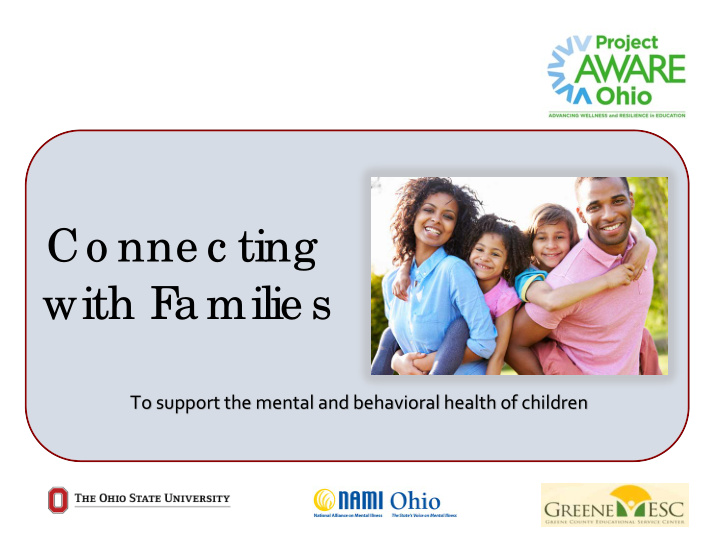



Co nne c ting with F a milie s To support the mental and behavioral health of children 1
Presenters Barbara Boone, Ph.D. Angela Schoepflin The Ohio State University National Alliance on Mental Illness, Ohio Grace Schoessow, MS Meredith Wellman, Ph.D. The Ohio State University Early Childhood Mental Health Consultant, Greene County 2
Overview the module • Learning opportunity for groups of professionals and/or parents who care for children or teens • Focus on engaging families to support mental and behavioral health of children and teens • Pause for reflection, writing or group discussion 3
Learning Objectives Participants will… 1. Compare family engagement and traditional parental involvement. 2. Reflect on the changes in families and caregivers over time. 3. Reflect on the experience of families and the experience of professionals when trying to work together. 4. Recognize family engagement as an area for on-going professional skill development. 5. Understand the science behind engagement: the parent's experience and the professional’s experience. 6. Practice using a self-reflection tool for professionals and families to assess the quality of interactions. 7. Commit to improving family engagement skills in one area. 4
Family Parent Involvement Engagement 5
PAUSE THE VIDEO Complete this Activity before continuing to watch the presentation: Think about the caregivers of the children in your center. 1. How have families changed in your years as a professional? 2. What is a family to you? 3. What is engagement in your mind, how is it different than parent involvement of the past? Spend a few minutes recording your own thoughts – If you are watching this with a coworker or a team, discuss your results. 6
The SCIENCE Behind Engagement 7
Hypothalamus Frontal Lobe Amygdala Hippocampus Brain Stem
Our brain state influences our actions and reactions.
PAUSE THE VIDEO Complete this Activity before continuing to watch the presentation. Think about a time when you were working with a family and things got tough. Maybe you had to deliver bad news, or maybe a child was acting out. Maybe the child’s parent was having a hard time understanding or valuing your services. How did you feel? What went through your mind? 11
When adults have opportunities to build their core skills they are enhancing the complex neural networks responsible for executive function and self regulation necessary for the stable responsive environments in which children thrive.
Skills for Professionals Respectful practices that build trusting relationships. 13
Helpful Change Hopeful
Helpful Provide specific self regulatory training (deep breathing, calming routines) Teach specific executive function skills Teach strategies for re-assessing stressful situations and consider alternative responses Teach strategies for recognizing and interrupting automatic (often emotional) reactions to allow for time for intentional self regulation in stressful situations. Strengthen intentional self regulation by building skills that override automatic responses
Hopeful Help parents identify their own motivators, goals and dreams for their child and family Help parents see how small changes make a difference Reinforce a cycle of positive emotional responses and successes Build confidence along with competence
Measuring Improvement in Skills How do we know if we are doing a good enough job of engaging and supporting families? 17
PAUSE THE VIDEO Complete this Activity before continuing to watch the presentation: Now, using the Help-giving Practices Scale rate yourself two times: 1. ONCE while thinking about a family with whom you have a good relationship. 2. and ONCE while thinking about a family with whom you have the most challenging relationship. * If you are watching this with a coworker or a team, take time to compare differences between the two and discuss your results. 18
Next Steps What is one skill you can develop or strengthen to make you a more effective when working with families? 19
Pause the video Complete this Activity before continuing to watch the presentation. Click on the Commitment handout located in the box on the bottom right of your screen. Select “download”. Once the attachment is downloaded you may complete your answers to the following questions: 1. What skills you have identified that you will commit to developing? 2. What is your plan for action to develop this skill(s)? 20
21
Connecting with Families Engaging Families to support the mental and behavioral health of children Barbara Boone, Ph.D. Angela Schoepflin The Ohio State University National Alliance on Mental Illness, Ohio Boone.32@osu.edu u.osu.edu/familyschoolpartnerships/ Meredith Wellman, Ph.D. The Ohio State University Grace Schoessow, MS Wellman.87@osu.edu Early Childhood Mental Health u.osu.edu/familyschoolpartnerships/ Consultant, Greene County 22
Recommend
More recommend